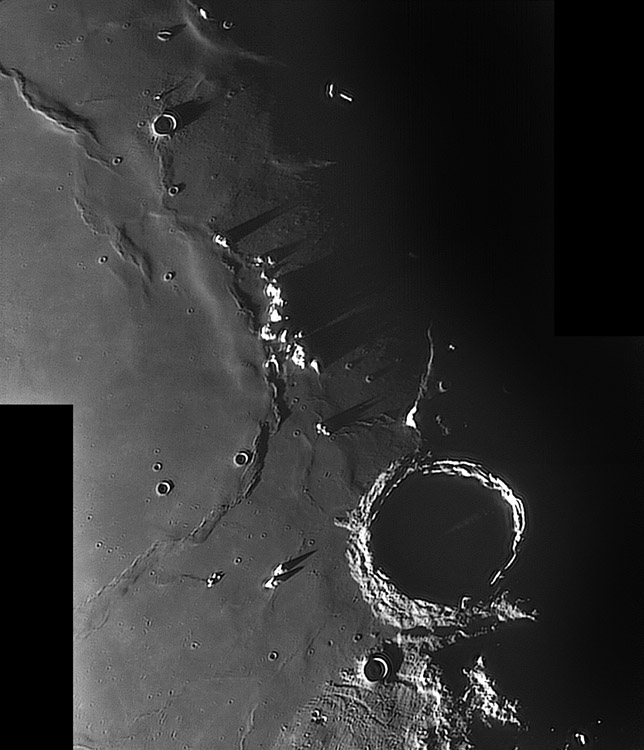Difference between revisions of "November 6, 2013"
| Line 6: | Line 6: | ||
<em>image by [mailto:jupiter182002@yahoo.ca/ Maximilian Teodorescu], Dumitrana (Ilfov), Romania</em><br /> | <em>image by [mailto:jupiter182002@yahoo.ca/ Maximilian Teodorescu], Dumitrana (Ilfov), Romania</em><br /> | ||
<br /> | <br /> | ||
| − | One of the most fascinating things to observe on the Moon is the rising or setting of the Sun across a mare. As the terminator moves across a generally smooth surface every bump shows up. Here on the eastern edge of Mare Imbrium the isolated [https://the-moon.us/wiki/Montes_Spitzbergen Spitzbergen Mountain range] casts stiletto-like shadows that noticeably lengthen or shorten over an hour at the eyepiece. At upper right, sticking up from the first darkness of a coming 14 day lunar night is the roughly T-shaped [http://lpod. | + | One of the most fascinating things to observe on the Moon is the rising or setting of the Sun across a mare. As the terminator moves across a generally smooth surface every bump shows up. Here on the eastern edge of Mare Imbrium the isolated [https://the-moon.us/wiki/Montes_Spitzbergen Spitzbergen Mountain range] casts stiletto-like shadows that noticeably lengthen or shorten over an hour at the eyepiece. At upper right, sticking up from the first darkness of a coming 14 day lunar night is the roughly T-shaped [http://www2.lpod.org/wiki/May_28,_2010 Piton Gamma] peak that may be part of an Imbrium inner ring. Near bottom center, just west of shadow-filled [https://the-moon.us/wiki/Archimedes Archimedes], is the peak Archimedes Zeta, a designation given by Mädler 180 years ago, that has shadows showing that it is twinned peaked. An inverse shadow - both in the direction of its tip and in being bright rather than dark - crosses the floor of Archimedes. The light is leaking through a low spot of the crater's western rim - the LRO altimetry data show the [http://bit.ly/1ei2D9o low spot] is about 650 m lower than adjacent normal rim heights. Finally, at the bottom center the low illumination emphasizes the sharp boundary between the mare lavas and the older [http://adsabs.harvard.edu/full/1978LPSC....9.3379S Archimedes Bench Formation]. LRO altimetry shows that the boundary is due to an abrupt steepening of slope. The flat-lying lavas flowed up against the rising Bench and could go no further.<br /> |
<br /> | <br /> | ||
<em>[mailto:tychocrater@yahoo.com Chuck Wood]</em><br /> | <em>[mailto:tychocrater@yahoo.com Chuck Wood]</em><br /> | ||
| Line 14: | Line 14: | ||
<br /> | <br /> | ||
<strong>Related Links</strong><br /> | <strong>Related Links</strong><br /> | ||
| − | <em>[ | + | <em>[[21st Century Atlas of the Moon|21st Century Atlas]]</em> chart 18.<br /> |
Max's [http://maximusphotography.wordpress.com/2013/03/30/colaj-lunar-2-octombrie-2012/ website]<br /> | Max's [http://maximusphotography.wordpress.com/2013/03/30/colaj-lunar-2-octombrie-2012/ website]<br /> | ||
<br /> | <br /> | ||
Latest revision as of 08:35, 28 October 2018
A Stiletto's Gap And Archimedes' Bench

image by Maximilian Teodorescu, Dumitrana (Ilfov), Romania
One of the most fascinating things to observe on the Moon is the rising or setting of the Sun across a mare. As the terminator moves across a generally smooth surface every bump shows up. Here on the eastern edge of Mare Imbrium the isolated Spitzbergen Mountain range casts stiletto-like shadows that noticeably lengthen or shorten over an hour at the eyepiece. At upper right, sticking up from the first darkness of a coming 14 day lunar night is the roughly T-shaped Piton Gamma peak that may be part of an Imbrium inner ring. Near bottom center, just west of shadow-filled Archimedes, is the peak Archimedes Zeta, a designation given by Mädler 180 years ago, that has shadows showing that it is twinned peaked. An inverse shadow - both in the direction of its tip and in being bright rather than dark - crosses the floor of Archimedes. The light is leaking through a low spot of the crater's western rim - the LRO altimetry data show the low spot is about 650 m lower than adjacent normal rim heights. Finally, at the bottom center the low illumination emphasizes the sharp boundary between the mare lavas and the older Archimedes Bench Formation. LRO altimetry shows that the boundary is due to an abrupt steepening of slope. The flat-lying lavas flowed up against the rising Bench and could go no further.
Chuck Wood
Technical Details
October 27, 2013. C11@F/25, ASI120MM, IR-pass filter (685nm). CAW over-enhanced Max's image to highlight the shadow features.
Related Links
21st Century Atlas chart 18.
Max's website
Yesterday's LPOD: A Dog's Breakfast
Tomorrow's LPOD: Silly Big Image, Silly Diverse Rilles
COMMENTS?
Register, Log in, and join in the comments.



